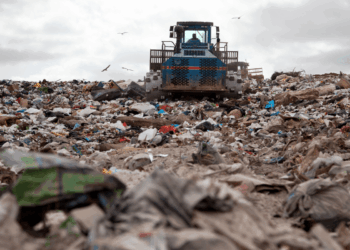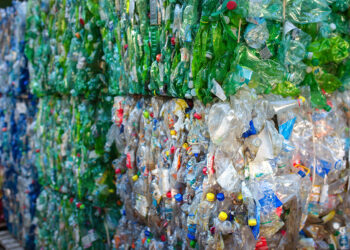The amount of material Oregonians disposed of in 2022 dropped significantly from the year before, but that was largely due to fewer building-destroying wildfires, according to the latest state Material Recovery and Waste Generation Rates report.
Overall, the state reported about 6.1 million tons of material generated, down 6.2% year over year, with 3.7 million tons going to landfills and incinerators and 2.4 million tons recovered. That’s a 8.8% decrease in tonnage going to landfill and a 1.8% decrease in tonnage recovered compared to 2021.
The weight-based recovery rate came in at 39.4%, an increase of about 2% from 2021 but still below the goals by the Oregon Legislature, which are 52% recovery by 2020 and 55% recovery by 2025.
The report noted that several factors contributed to lower-than-anticipated recovery: In 2015, a large paper mill that used post-consumer wood as a fuel shut down, and other mills also stopped using wood for fuel, “strongly impacting the ability to recover and use wood.”
China’s National Sword policy in 2018 also affected the recovery rates, which the state “did not anticipate” when setting the initial goals. The report noted that the state’s extended producer responsibility law, the Plastics Pollution and Recycling Modernization Act, “will significantly affect recycling operations starting July 2025.”
“The law has numerous aims and expands the concept of successful recycling beyond the weight based generation and recovery rates described in this report,” the report stated. “The law’s goals include making recycling easier for the public to use, expanding access to recycling services, upgrading recycling facilities, and reducing social and environmental harms. In 2025 and beyond, this report may look substantially different.”
2022 statistics
The material recovery rate includes materials that were recycled, composted and burned for energy. In 2022, 64% of the material recovered was recycled, 25% was composted and 11% was burned.
Broken out by percentage and weight, around 28.5% of the material recovered in 2022 was metals, 25.2% was yard debris, 19.1% was cardboard, 10.3% was wood, 7% was other papers, 4.2% was glass, 3% was food waste, 2% was plastic, 1.9% was “other,” and 0.4% was electronics.
In late 2020 and 2021, wildfires destroyed more than 6,000 structures, creating about 383,000 tons of fire debris, excluding asbestos-containing debris. In 2022, wildfires destroyed two structures, which accounts for most of the decrease in total material generated between the two years, the report noted.
“If the wildfire debris was excluded from 2021 disposal, then 2022 disposal would have been 27,368 tons higher than in 2021, generation would have been only 16,203 tons lower instead of nearly 400,000 tons lower, and the recovery rate would have dropped from 40% in 2021 to 39.4% in 2022, instead of rising nearly two percent,” the report added.
Looking at specific materials, in 2022 scrap metal recovery increased by about 64,000 tons, or 12%. Aluminum increased almost 10%, to about 40,000 tons in 2022, while tin can recovery decreased by 220 tons.
Recovery of tires increased by about 7,000 tons compared to 2021, and electronics recovery decreased by 10%. The state reported 5,600 fewer tons of lead acid batteries recycled in 2022.
Meanwhile, organics recovery fell by about 69,000 tons, or 7%. Cardboard fell by about 19,000 tons, or 4%, compared to 2021, and paper fiber overall fell by about 5%.
That decrease is due to the continuing decline of newspaper and magazine printing, the report noted. In 2004, newspapers made up 42% of material households put in curbside bins in the Portland metro area, compared to 3% in 2023, and magazines fell from 11% to 4.7% in the same timeframe.
The percentage of cardboard in curbside recycling, meanwhile, was 15% in 2004 and 43% in 2023.
“Some of the increase in cardboard on a percentage basis is simply due to the drop in newspaper, magazines and other printing and writing paper, but the absolute amount of cardboard has also increased in residential recycling, as households receive much more cardboard through mail-order than they did in the past,” the report stated.
Plastics fell by 5,000 tons year over year. A total of about 29,000 tons of rigid plastic containers were collected for recycling in 2022, down from about 32,000 tons in 2021. Film collection specifically dropped by just under 3,000 tons, from about 10,000 tons in 2021 to 7,000 tons in 2022.
“The tonnage of rigid plastic containers fell about 2,000 tons from the all-time high in 2021, but still is higher than the average tons recycled over the previous decade,” the report noted. “Other rigid plastics and film plastics are not included in any curbside or commingled recycling program in Oregon, and so most of the recycling of these materials is done through commercial or private programs or some drop-off recycling.”


























